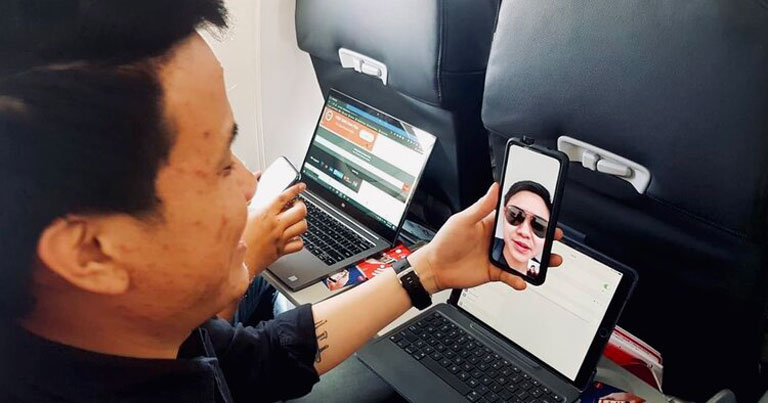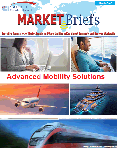Advanced Mobility Solutions
by Elisabeth Tweedie
Los Angeles, Calif., March 18, 2022-- For many people one of the numerous frustrations of the last two years has been being “grounded”. Travel was one of the hardest hit sectors during Covid. Not only did many countries close their borders, in many parts of the world local restrictions, coupled with fear of catching the virus, kept people close to home, so similarly impacting domestic and international travel. So it is hardly surprising, that as vaccinations make travel safer, and restrictions are lifted, people are starting to travel again for both business and pleasure. This is fueling a resurgence in all sectors of the travel industry.
It wasn’t that long ago that travel was viewed as an opportunity “to get away from it all”. Now travel is viewed as an opportunity to “take it all with you!” Whether for business or pleasure, in the air, on land or at sea, one thing all passengers have in common is the expectation that their all-important digital life will continue whilst they are on-the-move. Whether passengers want to work, stream movies, play online games, access social media or video chat there is an increasing expectation that this will not only be possible, it will also be easy and suffer no diminution of quality.
This is a pretty tall order, coming as it does during a data explosion. On the demand side of the equation, video is migrating from HD to 4K meaning that, at a minimum, four times the bandwidth is required. Users are also acquiring and using more devices. Passengers may simultaneously be doing email on a smart phone and working on a laptop, whilst at the same time watching a video on a tablet out of the corner of one eye. And in the case of airline passengers, doing all this while flying at nearly 600 mph. On the supply side, the amount of on-orbit capacity is also undergoing exponential growth, primarily fueled by the vast number of low earth orbit satellites (LEOs) currently being launched. However, medium earth orbit satellites (MEOs) and Ultra- or Very-High Throughput (U/VHTS) and software-defined geostationary satellites (GEOs) are also adding to the growth.
meaning that, at a minimum, four times the bandwidth is required. Users are also acquiring and using more devices. Passengers may simultaneously be doing email on a smart phone and working on a laptop, whilst at the same time watching a video on a tablet out of the corner of one eye. And in the case of airline passengers, doing all this while flying at nearly 600 mph. On the supply side, the amount of on-orbit capacity is also undergoing exponential growth, primarily fueled by the vast number of low earth orbit satellites (LEOs) currently being launched. However, medium earth orbit satellites (MEOs) and Ultra- or Very-High Throughput (U/VHTS) and software-defined geostationary satellites (GEOs) are also adding to the growth.
New Ground for Service Providers
For the last few years, we’ve heard a lot about “new space,” but it’s only very recently that we’re hearing about “new ground,” and yet the former would not be possible without the latter. No matter how much satellite capacity is available, if the ground infrastructure isn’t sophisticated enough to handle the multiple handovers between beams, satellites, frequencies and orbits, required by the GEO and non-geostationary (NGSO) satellites alike; new space would be dead space!
Challenging as these requirements are, they are magnified when it comes to supporting the travel industry. Not only does the infrastructure need to support beams and satellites that are constantly moving and changing, the ship or vessel’s location is also changing; and as already mentioned in the case of airline passengers, changing very rapidly.
While there may be specific pieces of equipment for the different markets – the modem for the aeronautical market will be different to that used for maritime for example - underlying this is a common set of requirements that service providers must meet, so that the shipping company or airline can respond to the increasing demands and expectations of these passengers.
In order to help their customers, service providers need equipment and software that will enable them to:
- Successfully manage an aggregate bandwidth pool from many beams from multiple satellites.
- Grow and expand the service cost effectively, with minimum disruption as new customers and satellites come into service.
- Deliver enterprise-grade availability and resiliency.
- Comply with all local regulations, which change as passengers cross through or over different countries and territorial waters.
- Avoid interference, which can be more of an issue in mobility where size, weight and power (SWaP) limitations dictate the need for smaller antennas.
- Integrate seamlessly with terrestrial networks.
- Keep the total cost of ownership (TCO) low.
Behind the Scenes of Advanced Mobility to Deliver the Best Passenger Experience
From the passengers’ point of view, there is only one requirement for their “on-the-move” digital experience: it must be indistinguishable from digital experience at home or in the office. What appears to be a seamless experience for the passenger, is actually the result of a remarkable and sophisticated set of network and physical technologies, namely, bandwidth management, network management, regulatory compliance, physical beam switching, waveform innovation, and equipment. The final necessity for mobility service provision is scale, the ability to grow incrementally and on demand while still conducive to the bottom line.
Bandwidth Management
Global bandwidth management is a key element in service provision. Service providers select and aggregate satellite bandwidth from multiple operators, satellites and spot beams, orbits and frequencies into a single bandwidth pool. This capacity pool is dynamically shared between customers and between customers’ vehicles according to their Service Level Agreements (SLAs) which delineate priorities, applications and device types. Bandwidth management incorporates a myriad of SLA factors including features such as Load Balancing, Service Scheduling, Geoscope and Fair Access Policy (FAP), in order to manage congestion and optimize fill rates.
Maximizing the value of a shared bandwidth pool requires advanced Quality of Service (QoS) for traffic prioritization and bandwidth management. An airline, for example, can establish distinct QoS settings by modem, bandwidth groups and applications. As bandwidth demands fluctuate across a fleet of aircraft and among passengers onboard – all of whom are sharing a common pool of bandwidth – SLAs can be configured and prioritized in highly flexible ways unlike conventional QoS. Global bandwidth management is important now and will become even more so in the future as more and more LEOs and MEOs come on stream.
Network Management
As the epicenter of a very complex set of operations, sound network management is increasingly becoming the measure of an operator’s success. A robust network management system manages large-scale deployments, monitors network activity, measures profitability and determines customer satisfaction. Network-level bandwidth management ensures overall quality of service across a customers’ fleet, guarantees individual vehicle SLAs, and maximizes use of capacity. It also ensures that fluctuating demand, different antennas and customer specific Quality of Service (QoS) and Service Level Agreements (SLAs) can all be handled. A global network management system allows tracking to ensure a consistent connection as modems pass from network to network around the world. In turn, this allows service providers the capability to monitor and manage each modem. As vessels and planes traverse the globe, these modems will connect to many different hubs, but each will be uniquely identified by a fixed global IP address.
Regulatory Compliance
Many regions and countries have unique regulations which pertain to the satcom equipment or signal as it moves between sovereign states and through territorial waters. Therefore, a Service Provider offering mobility services must ensure that these are all adhered to, including frequency use and radiated power limitations as well as no-transmit areas, all of which may change during a journey. New flat panel or electronically steered antennas primarily designated for on-the-move applications, for example, might exceed power spectral density limits which may change by location resulting in penalties. Therefore, it is important that system configurations take all regulatory factors into account and change in response to location. A mobility network platform must have the ability to manage these regulations automatically; regulations which grow in complexity as customers grow and expand their service area.
Beam Switching Technology
As satellites pass overhead and/or the vehicle moves, the signal needs to reconnect so that the change is imperceptible to the passenger. The onboard modem needs to maintain a constant IP session as the modem crosses multiple spot beams in a short period of time. Enhancements to basic beam switching technology facilitate this. These include automatic beam switching, so no manual intervention is needed, innovations at both the hub and modem which facilitate fast beam switching and fast reacquisition should blockage occur, and beam switching Application Program Interfaces (APIs) which allow (or permit) a user to customize the beam switching algorithm logic.
Onboard & Waveform Technology
In order to provide superior two-way broadband connectivity to moving antennas, additional technology is layered onto the basic modem functionality. The main technologies that are critical include: OpenAMIP-based protocol to facilitate the exchange of information between the airborne antenna and the satellite router; skew angle support to ensure compliance with adjacent satellite interference limits; doppler compensation to account for the change in the frequency wave perceived by the receiver; multicast overlay to support distribution of content management and spread spectrum waveform technology to significantly reduce the risk of causing adjacent satellite interference from small antennas. Additionally, specialized integrated modem boards, specifically for aero, are optimized for size, weight and power and must comply with strict standards such as DO-160G and ARINC 791. Pairing these mobility-specific functions with new waveforms for increased efficiency and throughput, can enable an instantaneous connection in networks with fast-moving remotes, similar to that achieved by a terrestrial network.
Scalability & Total Cost of Ownership
“...Despite the many advances, more evolution of the ground segment and advanced mobility is on the horizon. There are basically three concepts which service providers and their customers should be tracking: virtualization, standardization and orchestration. These are the key building blocks on which convergence and interoperability can be built...” |
Scalability is fundamental to the success of any business. For mobility-based companies, the flexibility to build out infrastructure in-line with demand, is key to managing total cost of ownership (TCO). No service provider wants to have to redesign the system as usage grows, or when it expands its coverage to take advantage of new satellites and orbits as they come into service. Not only is it important to be able to access the new satellites, but they also have to be integrated into existing systems to deliver a single unified service. That service ideally can provide more capacity and higher speeds, without a significant increase in cost.
TCO is a major consideration for any service provider contemplating upgrading its hubs and remotes in order to take advantage of the new reality of expanding mobility markets, greater satellite capacity and new orbits. As a result of significant investment in innovative technology, ST Engineering iDirect offers modular design hubs providing a pay-as-you-grow network for its customers.
Cruise Passengers
The cruise industry was particularly badly hit by Covid-19, essentially grinding to a halt as the pandemic swept around the world. As more people are vaccinated and the industry has instigated new health protocols, it is experiencing a revival, although this statement comes with the caveat that the full long-term impact of the new variants on the industry is unknown at the time of writing Nevertheless, as we await to see what unfolds, cruise lines are ramping up operations, and for some operators, bookings for 2022 are already higher than those in pre-pandemic 2019.
As mentioned in the introduction, Covid-19 temporarily slowed or halted growth across all of the mobility sectors. However, as the world gradually opens up and learns how to cope with new variants of the virus, optimism is returning. Numbers of installations, as well as bandwidth consumption continue on their upward trajectory, after the covid hiatus. NSR is predicting that the number of VSAT broadband equipped passenger vessels will experience a 6% CAGR to 2030, whereas MSS broadband will not experience any growth. According to
NSR there are currently nearly 70,000 broadband enabled vessels in total, and this is predicted to grow to over 142,000 by 2030. This of course, includes commercial shipping and fishing fleets as well as passenger vessels.
Connectivity at sea was changed by HTS. Previously, the vast majority of services were limited and costly. HTS ushered in a new era of VSATs at sea, and as cruise passengers got a taste of being able to share photos or even watch video, demand for bandwidth grew. Provision of reliable broadband is giving cruise companies a competitive edge in the market for customers.
Based on two scenarios, high case and low case, the analysis forecasts that the total number of connected aircraft will reach between 16,000 and 20,000 by the end of this decade.
Airline Passengers
Aviation is arguably one of the most demanding of the mobility markets. As previously discussed, planes are moving at high speed, across multiple beams and satellites whilst traversing different regulatory systems.
The aeronautical market is predicted to experience even greater growth than maritime, over the same period, with NSR predicting just over an 8% CAGR in units-in-service in its low-growth scenario and nearly 11% in its high-growth scenario. At the low end this translates to a doubling of units from ~50,000 in 2020 to ~100,000 in 2030. Currently, most of this growth is coming from HTS, but the LEO constellations are clearly making a play for a piece of this market. SpaceX has recently filed with the FCC for up to 500 earth stations aboard aircraft and Elon Musk tweeted that “SpaceX is focusing on B737 and A320, as those serve the greatest number of people.” OneWeb, is also targeting the IFC market, and signed an agreement with SatixFy in March to develop an aeronautical terminal. On its website it states that the antenna will significantly reduce drag and fuel consumption compared to other antennas. Telesat, already a major player in the IFC market with its GEO fleet, is now committed to its own LEO constellation.
Despite the buzz surrounding the LEO market, it is clear that service providers are wary and are not anticipating early success for the technology. IFC service provider Anuvu has recently announced its intention to supplement a possible transition to LEO with a micro-GEO constellation as well as holding the expectation that HTS GEO will always be necessary for areas of high demand.
Both business and commercial aviation were hit hard during the pandemic, and both are now experiencing a resurgence. Although still down 21% from June 2019 (pre-pandemic) numbers, according to statistics from the US Bureau of Transportation, US airlines overall carried 304% more passengers in June 2021 than June 2020. This breaks down to an increase of 276% for domestic passengers and 1,450% for international passengers.
Business aviation is experiencing an even greater resurgence. This is likely attributable to both concerns about the health risks of commercial flights and the strong stock market, both of which serve to lead wealthier travelers to seek a more exclusive experience. According to Wingx Business Aviation Bulletin, in spite of regional variations due to the Omicron variant, at the end of the first week of December, globally business aviation departures were up 6% on 2019 and 48% on 2020. In the United States, at the end of the first week in December cumulative domestic business jet departures were up 3% on 2019, but this statistic conceals some very strong months. During November for example departures were up 20%.
 |
| To read or download a pdf of a MarketBrief report on Advanced Mobility Solutions sponsored by ST Engineering iDirect click here. |
Rail Passengers
Although lagging behind aeronautical and maritime, there are currently a few installations of communications for land-based passengers on the move. This is expected to increase as flat-panel electronically steered antennas become more readily available and affordable, and the price of bandwidth continues to fall. Elon Musk has already indicated that trains are one segment being considered for Starlink. Some of the existing installations rely on cellular, however, high-speed trains can transition between cellular base stations at speeds faster than some of the terrestrial networks are able to cope with. Also, during the course of a journey, many trains will pass through areas of no cellular coverage, making a hybrid cellular/satellite solution the obvious choice for both issues
Hispasat is one of the leading providers of satellite services for rail passengers, with installations dating back to 2004. Its latest installation is for Renfe, the state-owned Spanish rail operator. This hybrid service, provided in partnership with cellular operator Telefonica, links satellite and 3G/4G for continuous connectivity and quality of service relying on fast signal reacquisition as the train travels at up to 350km/h. The service provides internet access, video-on-demand and multicast TV to passengers on 89 trains.
Looking Ahead
Despite the many advances, more evolution of the ground segment and advanced mobility is on the horizon. There are basically three concepts which service providers and their customers should be tracking: virtualization, standardization and orchestration. These are the key building blocks on which convergence and interoperability can be built. They will form the connective tissue to bring the 5G cloud-based telco-aligned reality to fruition and thus realize multi-orbit, multi-access, multi-service, multi-vertical service agility.
Virtualization, based on open source to bring forward improved scaled, performance and security will reduce operational complexities resulting in a fully digital ground segment that can integrate with terrestrial telecom networks to enable 5G. Standardization allows seamless integration between satellite and terrestrial networks for global mobile communication systems. Orchestration means end-to-end service automation to harness the full potential of high-throughput, high-efficiency networks.ST Engineering iDirect is a member of the Digital IF Interoperability Consortium (DIFI) which promotes open standards between space and terrestrial interfaces with the goal of enabling virtualization of the modem infrastructure. Advances in resource orchestration through virtualization of networks and baseband functions will provide flexibility for supply and demand.
Today and into the future, Service Providers require networks with features that enable them to deliver scalable, customized, and efficient services to their end-users, thereby maximizing revenue and limiting costs.
ST Engineering iDirect Technology: A Fit for Any Service Provider
Service providers of all sizes are looking for a step change in capabilities. As the new NGSO constellations and advanced GEO satellites come online, the need for flexible, efficient, scalable ground systems will become even more important. With three robust platforms today—Dialog, Evolution and Velocity—and next generation capabilities under development, ST Engineering iDirect has rightly earned its reputation for remarkable advanced mobility platforms for air, land, and sea. Whether a service provider wants to adopt a new platform with high-efficiency waveforms suitable for a greater range of applications while minimizing operational complexity, maximizing statistical multiplexing, and adding further scalability or grow an already large scale maritime network with high QoS, or become an operator of managed services that require massive scale and advanced bandwidth management with very fast beam switching across hundreds of spot beams globally, ST Engineering iDirect has the innovation and technology to be relied upon for the best advanced mobility has to offer.
--------------------------------------------
 Elisabeth Tweedie has over 20 years experience at the cutting edge of new communications entertainment technologies. She is the founder and President of Definitive Direction (www.definitivedirection.com), a consultancy that focuses on researching and evaluating the long-term potential for new ventures, initiating their development, and identifying and developing appropriate alliances. During her 10 years at Hughes Electronics, she worked on every acquisition and new business that the company considered during her time there. She can be reached at etweedie@definitivedirection.com
Elisabeth Tweedie has over 20 years experience at the cutting edge of new communications entertainment technologies. She is the founder and President of Definitive Direction (www.definitivedirection.com), a consultancy that focuses on researching and evaluating the long-term potential for new ventures, initiating their development, and identifying and developing appropriate alliances. During her 10 years at Hughes Electronics, she worked on every acquisition and new business that the company considered during her time there. She can be reached at etweedie@definitivedirection.com






